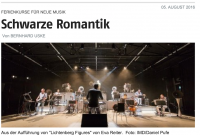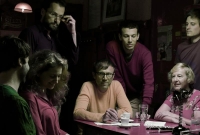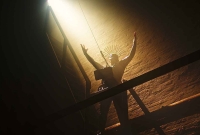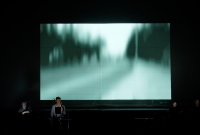SUMMER COURSE FOR NEW MUSIC
Dark romanticism
By BERNHARD USKE
Original German version
From the performance of “Lichtenberg Figures” by Eva Reiter.
Eva Reiter’s “Lichtenberg Figures” at the summer course for new music – portrayal of modern sensitivity with fragile touches of reality.
She is innately a graduate fipple flute and viola-da-gamba player – Eva Reiter, born in 1976 in Vienna, who appeared at the Darmstadt summer course for new music. Not at the event’s original location but instead in Frankfurt where the course’s bigger concerts have been held in the past. This year there has been an effort to revive the original Hessian avant-garde topography and organizers have made (in addition to the Hessian radio studio) the LAB Frankfurt the northern new music outpost of the south
Hessian headquarters.
“The Lichtenberg Figures” – a piece for voices of just under an hour with 11 instruments and electronic music – was on the programme of the extensive experimental and performance workshop in western Frankfurt. A piece also by the early music instrumentalist Eva Reiter, who not only masters her traditional instruments but also the array of sounds that has continually been disassembled into sound-noise conglomerates and fused together again since the days of futurism through to the present.
It was reminiscent of Luigi Russolo, the musical futurist and his horn orchestra from the 1910s, the intonarumori. Ten large gramophone cylinders on the LAB stage provided the optically dominant impression here. Each of the performers in the Ictus ensemble as well as the piece’s creator were equipped with one of these which were occasionally used more symbolically than to produce sound.
Sonnets set to music
Eva Reiter stood elevated on a rostra which occasionally began to light up like that of the instrumentalists. Reiter was the event’s dominant figure vocally but very reserved in terms of physical gestures. The musicians used both classical and electrical instruments (electric guitar, e-bass). Seven songs ¬– some sonnets by the US author Ben Lerner set to music – made up the core element of the piece. Portrayals of modern sensitivity with fragile touches of reality, disastrous-seeming performances and sobering inspirations – dark romanticism transformed into contemporary means of dialogue. Some called it a ‘pre-emptive elegy’ – which seemed appropriate.
Eva Reiter presented the texts giving a flamboyant gestural performance with masterful use of the voice, sometimes more affective and then using vocal sounds again – all incorporated into the sound process of the instrumental ensemble which performed all variants of hybridised synthesis and combinations and fragmentations of the sound figures and timbres. A permanent influx and constant fusion of contours in the form of dynamic statics.
Mood and atmosphere as the ultimately lasting impressions also suggested a modern, romantic range of experiences here. Flexibly articulated, subtle sound inflections and intense in the rise and fall of the sound flow – the attunement of vocal, analogue and electronic sounds was exquisite and largely attributable to the precise performance and phrasing of the Ictus conductor Georges-Elie Octors.





